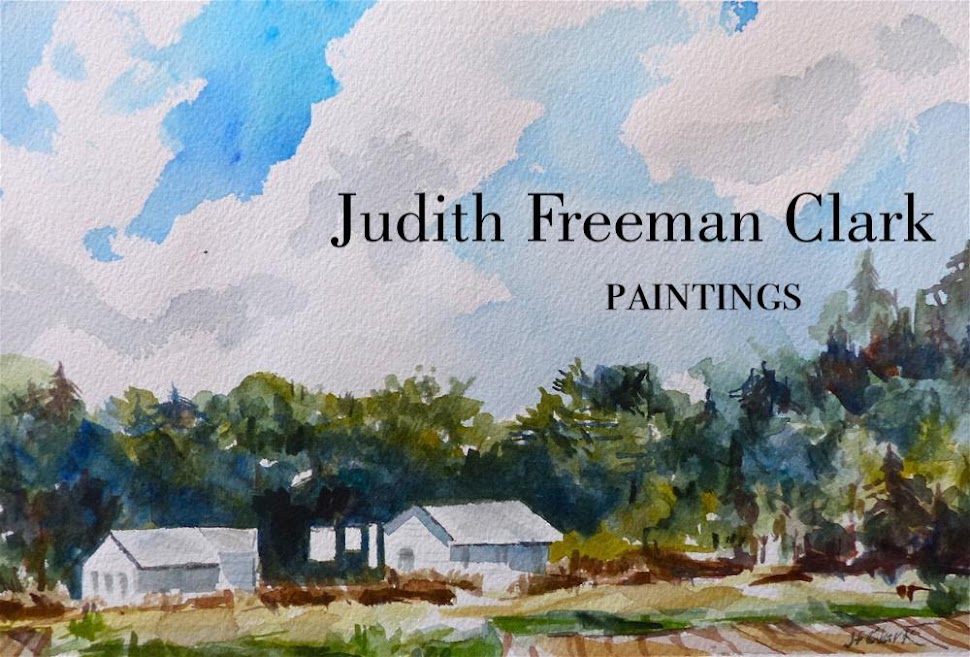I've started an 8-week independent study watercolor class, offered at
New England School of Fine Art (NEFSA) in Worcester, MA. Our class is a group of approximately twenty artists working in various mediums. Many are watercolorists, and a few of us have been in classes together in the past. I continue to attempt to "loosen up" my approach to painting in watercolor. So the goal in my first three-hour class was to attempt a freehand landscape, relying only on my ability to render accurately with a paintbrush –– and
no pencilled-in guidelines.
My reference photo is one I took at Tower Hill Botanic Garden in Boylston, MA, several summers ago. While I don't intend to replicate the scene exactly, I hope to evoke a sense of the place as I use this photo (and several others taken at the same time) as a basis for my landscape exercise.
 |
| Reference photo |
Step 1 (above) My paper is a quarter-sheet of
140-lb. Kilimanjaro Original White, from
Cheap Joe's (my go-to source for art supplies). I prefer 300 lb. paper, but I have a few more sheets of 140-lb. to use up and this seemed like a good opportunity. I began by covering the upper half with a pale, thin wash of Pthalo Blue, using a 2" Robert Simmons Skyflow brush, and after this dried I added shapes of green for the foliage (trees and low bushes, a suggestion of garden plantings, etc.) For these shapes, I used diluted washes of Green Gold, Undersea Green, Yellow Ochre, Shadow Green, and a very pale wash of Pthalo Blue (which can be too intense if used straight from the tube).
Rinsing my brush (a #12 pointed round) with each color change, I allowed the first splotches and puddles of colors to mingle on the paper. This produced some pleasing blends and soft edges (e.g. in the small clump of almost-white shrubs at far left). I dabbed in Burnt Sienna as a basis for some deeper-tone flowers, and then applied a thin wash of Green Gold and Pthalo Blue for the green lawn on the left. While this area was still damp, I added a bit of Shadow Green to the edge of the grass. I saved adding color to the distant curving path for later; the photo shows it as paving stone but I may change it to the type of brick-work on the path in the photo's foreground.
Step 2 (right) I built up details slowly, trying always to keep it loose. Using a mixture of Shadow Green and Sepia for the deepest green colors, I indicating shaded parts of the trees, and just barely suggested tree trunks and a few branches with almost straight Sepia. Using darker, almost full-strength pigment for smaller details on the trees adds depth; cool, blue-ish green helps the distant foliage recede into the background. I began to paint the curving walkway by applying a thin wash of grey, made from mixing Sepia and French Ultramarine and lots of water.
Step 3 (left) Although this third image looks as if I added more color to the sky, I didn't -- I just photographed this one in a sunnier room!) I added more detail in the distant trees and mountains, using deeper mixes of Pthalo Blue, Shadow Green, and a bit of Permanent Sap Green. This background section is now approaching the strength I am hoping for, so I will probably not do anything else to it.
I continued to add shadows in the trees on the right, a few leafy details to the tree on the left, and more color variation in the largest evergreen in the middle. Alternating applications of pale washes of Mineral Violet, Burnt Sienna, and Pthalo Blue, I suggested banks of flowers –– again softening the edges by allowing the wet washes to mingle. In the foreground, I used stronger washes of those same three colors, and when these dried I added some leafy Green Gold and Permanent Sap Green details to suggest clumps of flowers. Mineral Violet combines beautifully with French Ultramarine and a wash of this along the garden edge of the path suggests a bit of a cast shadow.
Jo Ellen Reinhardt, our instructor (and founder of NESFA) suggested I look closely at what might be a problem area: a too-obvious diagonal that draws the viewer's eye from the lower right of the painting, to the left where it connects with the curving pathway. The task now is to find a solution.


















































